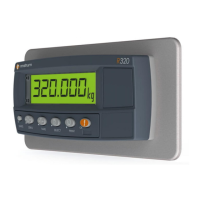Reference Manual V1.19 Software Versions 4.xx
Page 42 003R-682-119
9. Serial Outputs (K344, K35*)
The instrument supports a bi-directional RS-232 output and temporary opto-LINK connection,
allowing for a number of serial output types for communications with external devices such as
printers, computers, PLCs, or remote displays.
Refer to opto-LINK Activation page 16. For wiring connections and pinouts, refer to Auxiliary
Connection page 11.
Serial communications are supported in firmware variants K344 and K35*.
The instrument computer communications can range from simple automatic streamed output,
through to a command-response system. In addition to the opto-LINK, the instrument can be
programmed and calibrated via the RS-232 serial port. The calibration counter is incremented when
the calibration related steps are accessed via RS-232, the serial port or the opto-LINK. This means
that calibration via the serial port or opto-LINK cannot be carried out without affecting the certification
of a trade installation.
9.1. Serial Output Types
There are seven (7) types of serial output available and selected via (SERIAL:TYPE).
• Network Communications (NET)
o Two network options –
o NET network communications feature is normally used to control indicators remotely
from a central computer, or PLC
o Instruments can be installed in a Ring Network.
• Automatic Weight Output (AUTO)
o The automatic output is normally used to drive remote displays, a dedicated
o Select between two standard formats, master/slave and custom
• Single Output (SINGLE)
o The single output produces a single output with the formats selected. It is used to
drive remote displays, a dedicated computer, or PLC communications.
o Press <PRINT> key to transmit in selected format.
o A long press of the <PRINT> key has no effect.
o Select between two standard formats, master/slave and custom
• Printer driving (PRINT)
o Enables printer driving with either the standard print format or custom depending on
the firmware.
• Auto Print (AUTO.PR)
o In Industrial and NTEP modes a single printout occurs when the weight is stable after
being at zero, and higher than the zero band.
o In OIML mode a single printout occurs when the weight is stable after being at zero,
and higher than the greater of 20 divisions or zero band.
• Print Livestock Weight (PRN.LIV)
o Automatically prints when a new livestock weight is held (when using the LIVE.WT
function)
• Network Protocol SIMPLE (SIMPLE)
o The simple network protocol allows the indicator to respond to common simple ASCII
key press commands and enable the indicator to be used in legacy systems.

